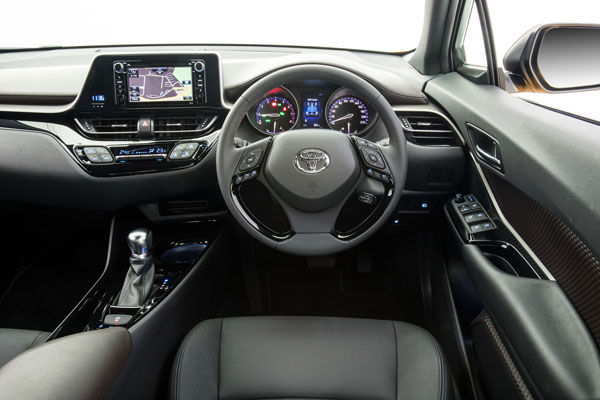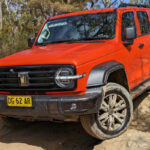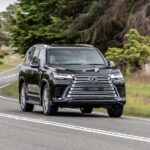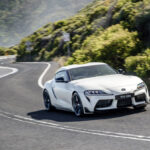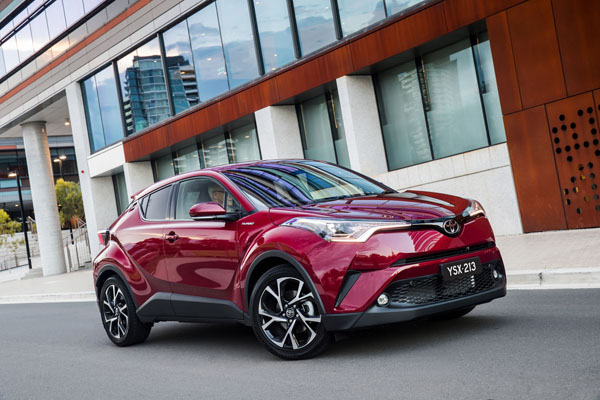
Late last century Toyota took the chisel to several models and carved a series of cutting edge designs that had the automotive world sitting up: think the curvy Celica; Tarago ‘egg’ people mover, the first RAV4 and the Prius petrol / electric hybrid. Other than that the Japanese penned plenty of rather bland shapes.
That has dramatically changed. In parallel with the rapid sales rise of SUVs, Toyota has come up with the radically-styled C-HR, standing for Coupe High Rider.
To say the C-HR is different is the mother of understatements, with extroverted looks setting onlookers on their heels.
Toyota Australia’s executive director sales and marketing Tony Cramb says, “C-HR will bring new customers to the Toyota brand – typically younger, image-conscious people who take a more emotional approach to purchasing a car compared with our more traditional customers.”
Available with manual or continuously variable automatic, in two-wheel or all-wheel drive, and two specification levels, prices start at $26,990 for the six-speed manual front-drive C-HR, increasing by $2000 for the automatic and a further $2000 for the traction of all-wheel drive.
Standard features include advanced safety technology and satellite navigation, alloy wheels and dual-zone automatic air-conditioning. Top-of-the-range Koba variants, named after chief engineer Hiroyuki Koba, add luxury features including leather-accented seats, keyless entry and ignition, bigger (18-inch) alloy wheels, LED lights and Nano-e technology that moisturises cabin air – all for an additional $4300. The Koba was our test machine.
STYLING
The title Coupe High Rider sums up the design of the C-HR, with its radical looks – coupe upper body and high-set stance of an SUV. The steeply sloped roofline tops off a lower body replete with curves and creases, especially around the rear. Coupe styling is further enhanced by ‘hidden’ rear door handles integrated high on the C-pillar
Toyota New Global Architecture has enabled key components to be positioned lower in the structure, allowing designers to produce dynamic looks with lower roof and bonnet heights.
The upper grille flows to the wing extremities of the headlamp clusters and wraps fully around the front corners of the vehicle. All C-HRs are fitted with LED daytime running lamps and fog lamps, while Koba variants feature bi-LED headlamps with sequential turn indicators, 12 LEDs that light up in sequence.
INTERIOR
Headroom is not compromised by the low roofline, thanks to the low seating positions. Interior space is similar to Corolla, comfortably taking four adults in leather accented seats (Koba) and offering 377 litres of luggage space along with a 60/40 split-fold rear seat.
A newly two-tiered front-seat design combines a slender, sporting upper section with a more strongly bolstered lower area. In Koba both have heaters and power lumbar adjustment.
Instruments and controls are focused on the driver, a small 6.1-inch touch-screen extending upwards from the instrument panel. Thin windscreen pillars, helps driver visibility.
To the left of the leather-bound steering wheel are audio and phone controls, on the right a Multi Information Display (MID) and safety system controls.
INFOTAINMENT
MID displays information through a full-colour 4.2-inch screen between the speedometer and tachometer dials. Controlled by switches on the steering wheel, the screen can display relevant information via an intuitive menu. MID screens include odometer and trip meters, instant and average speed and fuel consumption, a lateral-G meter (2WD) and a G-force meter (AWD). Satellite navigation is paired with Toyota Link and there’s a six-speaker sound system.
ENGINES / TRANSMISSIONS
The Toyota C-HR is equipped with a new design 1.2-litre turbocharged four-cylinder petrol engine delivering maximum power of 85 kW from 5200 to 5600 rpm and peak torque of 185 Nm between 1500 and 4000 revs. In the test vehicle it was mated with a CVT and all-wheel drive, offering three drive modes – Eco, Normal and Sport.
Eco mode will varies throttle pedal sensitivity to favour fuel economy while Sport goes for performance. In Sport mode, the CVT transmission has been tuned to simulate gear changes of a conventional automatic under hard acceleration.
CVT-equipped models can also be specified with Toyota’s Dynamic Torque Control, an electromagnetic all-wheel-drive system that can direct up to half of the engine’s torque to the rear axle.
SAFETY
C-HR offers a high level of standard safety features including a pre-collision safety system, active cruise control, autonomous emergency braking, lane departure alert with steering assist and reversing camera. All variants are equipped with seven airbags, stability and traction control, auto high beam, blind-spot monitor, rear cross-traffic alert, rain-sensing wipers, front and rear parking sensors and hill-start assist.
DRIVING
A puddle lamp projecting ‘C-HR’ on the ground beside the front doors is the first thing to attract comment when unlocking the car. From then on, be prepared to attract plenty of attention with the C-HR. Opinion was divided during the time I had the test vehicle. The out-there styling had its strident fans and critics.
The 1.2-litre four-cylinder turbocharged petrol engine made the most of its 85 kW peak power and maximum torque of 185 Nm between 1500 and 4000 rpm, delivering surprisingly spritely performance.
Fuel consumption of the high-revving engine over the test period varied between six and nine-plus litres per 100 kilometres under as varied a set of conditions normally experienced in day-to-day driving. Over the years, continuously variable transmissions have had their troubles with ragged performance. Not the C-HR, which gave smooth operation throughout the rev range. The CVT also offers M-mode for manual access to seven simulated gears, giving a driving experience similar to a traditional transmission.
The rear door handles came in for criticism, some passengers finding them awkward to operate at the angle and height they were set. The rear view was also limited by the steep angle of the roof.
Storage spaces include a seven-litre glovebox capable of holding a 1.5-litre bottle. The centre console is equipped with front and rear cup holders, each capable of holding a 500 ml bottle, a tray for storing a smartphone or music devices and a 4.2-litre console box.
SUMMING UP
If the C-HR is the forerunner of Toyota vehicles to come, all well and good. If the company retreats into the sausage-machine styling of years gone by it will be an opportunity missed to attract a new set of owners.
AT A GLANCE
MODEL RANGE
Toyota C-HR 2WD: $26,990 (manual), $28,990 (CVT)
Toyota C-HR AWD: $30,990 (CVT)
Toyota C-HR Koba 2WD: $33,290 (CVT)
Toyota C-HR Koba AWD: $35,290 (CVT)
Note: These prices do not include government or dealer delivery charges. Contact your local Toyota dealer for drive-away prices.
FEATURES
17-inch alloy wheels
Halogen projector-type headlamps LED daytime running lamps and fog lamps Rain-sensing wipers Roof-mounted spoiler Tailgate lip spoiler
Pre-collision safety system Autonomous emergency braking Active cruise control Lane departure alert with steering assist Sway warning system Blind spot monitor Rear cross-traffic alert Reversing camera Seven airbags, including driver’s knee airbag Vehicle stability and traction control Trailer sway control Anti-skid brakes Hill-start assist control Brake assist Electronic brake-force distribution Brake hold
Multimedia: 6.1-inch display audio with six speakers, AM/FM radio, CD player, USB and AUX input Bluetooth hands-free, music streaming, message, phone book, speech commands Toyota Link connected mobility: Fuel finder, local search, destination download, Toyota help (all with ‘drive to’ navigation capability), Weather, Pandora, travel times 4.2-inch colour multi-information display (MID)
Premium steering wheel with audio, phone, MID and driving switches
SPECIFICATIONS (Toyota Koba CH-R AWD 1.2-litre turbo-petrol SUV)
ENGINE:
Capacity: 1.197 litres
Configuration: Four cylinders in line
Maximum Power: 85 kW @ 5200-5600 rpm
Maximum Torque: 185 Nm @ 1500-4000 rpm
Fuel Type: Petrol 95 RON
Combined Fuel Cycle (ADR 81/02): 6.5 L/100km
CO2 Emissions: 148 g/km
DRIVELINE: Multidrive S CVT, Dynamic Torque Control part-time AWD
DIMENSIONS, WEIGHT AND CAPACITIES:
Length: 4360 mm
Wheelbase: 2640 mm
Width: 1795 mm
Height: 1565 mm
Turning Circle: 10.4 metres
Kerb Mass: 1510 kg
Fuel Tank Capacity: 50 litres
BRAKES:
Front: Ventilated disc
Rear: Solid disc
STANDARD WARRANTY:
Three years / 100,000 km





